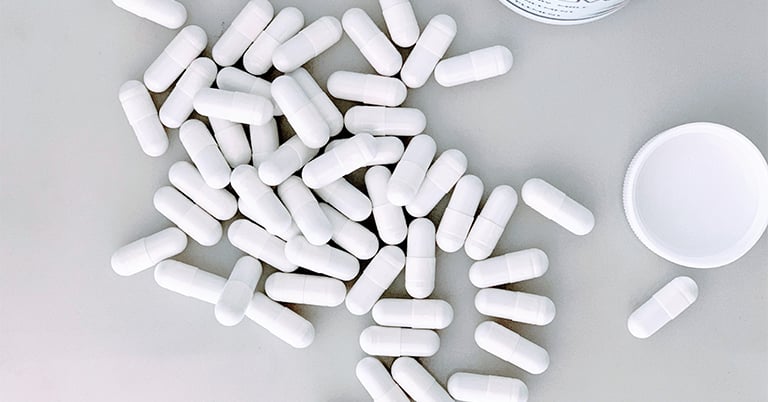Creatine has become one of the most popular supplements for athletes and gym-goers. Numerous studies back up the fact that creatine is one of the most beneficial supplements for athletic performance and increasing strength, as well as being well-tolerated by most people.
While many creatine users take it in the same way as you'd take a daily supplement, others do something known as loading creatine. In this article, we'll take a look at everything you need to know about creatine loading and how it can help you bust through plateaus and reach your fitness goals.
What Is Creatine?
Creatine is a naturally occurring substance that is found in our muscle cells. It aids the muscles by helping them produce energy during intense exercise such as heavy lifting. It does this by producing a high-energy molecule called ATP.
When you exercise you deplete the stores of creatine in your muscles. Less creatine in the muscles means the body can't produce as much ATP. So you have less energy.
Creatine can be sourced from red meat, fish, and seafood. However, the recommended daily amount of creatine is 5 grams. That would mean eating around 2.2lbs of steak a day!
This is why most athletes choose to supplement creatine, especially if they are vegetarian or vegan.
Creatine Benefits
Creatine has been found to have several benefits regarding exercise performance and body composition. It is predominantly used because it increases the possible workload of each workout. Higher volume workouts mean more progress.
Creatine has also been found to boost muscle recovery and growth, as well as reduce muscle breakdown. It has also been found to raise the presence of the anabolic hormone IGF-1. All of these factors help to ensure that you're able to give it everything you've got each time you hit the gym.
Quicker recovery means you can maintain a higher intensity throughout your workouts. Demanding more of the muscles means they are forced to adapt and grow. This means faster strength gains as well as increased muscle mass.
All of these benefits have made creatine one of the most used supplements alongside the different types of protein powders.
What Is Creatine Loading?
If you're new to creatine and you've just started searching for the best way to take it then you've probably stumbled across the term 'creatine loading'.
Many people using creatine take 5g a day like they would any other dietary supplement. Creatine loading, on the other hand, has an initial creatine loading phase which involves taking a larger dose of creatine for some time before dropping down to a maintenance dose.
Creatine Loading Dose
The most common creatine loading phase involves taking 20-25g of creatine daily for 5-7 days. This helps to build up the muscles stores of creatine as fast as possible. During the loading phase, the creatine dose should be spread out into 4-5 5g doses and taken throughout the day.
After the first 5-7 days you should drop down to 5g a day. This is known as the maintenance phase. Some people might recommend that after 4 weeks of taking 5g a day, you should take a week off. However, most individuals will continue taking creatine to keep muscle stores at full saturation.
The Benefits of a Creatine Loading Phase
The only real difference between using a creatine loading phase and taking 5g of creatine daily is the speed at which your muscles become saturated with creatine.
If you take 5g daily, then it can take around one month to reach full saturation. During the creatine loading phase, the muscles can reach full saturation after the first few days.
This being said, the main advantage of using a creatine loading dose is that you'll feel the benefits of creating much quicker and they'll be more noticeable. This can also increase your body weight as it promotes water retention and you are likely to see yourself becoming bigger during the loading phase. This can be a good psychological push for bodybuilders.
The Disadvantages of a Creatine Loading Phase
If you participate in a sport that uses weight classes (such as boxing) then suddenly getting heavier might be detrimental. If your sport relies on fast-paced athleticism and endurance then carrying that extra weight might dampen your performance.
Creatine can be beneficial for any kind of athlete, but those who are looking for an increase in athletic output without any noticeable size and weight gain should consider taking creatine at 5g a day and not bothering with the loading phase.
Some individuals complain that the high doses taken during the loading phase can lead to gastrointestinal discomfort. This is likely caused by increased water retention and intake. Again, if this is a problem it can be minimized by taking 5g of creatine daily rather than utilizing a loading phase.
But, Does Creatine Loading Work?
If you're trying to find the best way to take creatine whether or not you should try creatine loading depends on your goals. If your primary focus is bodybuilding or weight/strength gains, utilizing a creatine loading phase is a great way to reach optimum creatine muscle saturation as quickly as possible.
You'll feel the full benefits of creatine within the first few days of the loading phase.
If you're looking to take advantage of creatine without gaining any sudden weight then it might be best to skip straight to a daily dose of 5 grams. This way you'll reach full saturation in around 28 days, but immediate weight gain should be minimized.
The Best Way to Take Creatine
No matter if you're planning on utilizing a loading phase or taking creatine like a daily supplement from the start, it's important to know the best way to take creatine.
Creatine monohydrate mixes easily with drinks such as smoothies, protein shakes, or even your morning coffee. Some prefer to take creatine near their workout—either before or after. More important than the timing of when you take your creatine is the consistency in which you take it.
To take full advantage of the benefits of creatine, make sure you are taking it daily. On days you don't workout, you'll benefit from mixing creatine in directly into something you're already drinking. On training days, it may be easiest to take it with your pre-workout.
Take Full Advantage of Creatine
By now you'll know whether or not creatine loading is for you. Creatine is well-tolerated by most people but if you do suffer from any GI discomfort then drop down to 5g daily and you'll still be reaping the full benefits of creatine by the end of the first month.
If you're looking for the best way to mix your creatine, whether for loading creatine or for just easing your way into the supplement, then check out our full range of shakers.
FAQ:
1.What are the potential long-term effects of creatine loading on the body?
Research suggests that creatine loading is generally safe for healthy individuals. However, some potential long-term effects to consider include:
-
Upset stomach and muscle cramps: These are relatively common but mild side effects that may subside with continued use [WebMD].
-
Kidney concerns: While most research shows no significant impact on healthy kidneys, individuals with pre-existing kidney issues should consult a doctor before using creatine [WebMD].
It's important to note that more research is needed to fully understand the long-term effects of creatine loading, especially for individuals with specific health conditions.
2. Are there specific types of athletes or fitness goals for which creatine loading is more suitable or less effective?
Creatine loading is most beneficial for athletes engaging in short bursts of high-intensity exercise such as:
-
Weightlifters: Creatine can help improve performance in activities requiring explosive power, like weightlifting and sprinting.
-
Powerlifters: Similar to weightlifters, powerlifters can benefit from the potential increase in strength and power.
-
Interval training athletes: Athletes performing high-intensity interval training (HIIT) may also experience some benefits.
Creatine loading is generally less effective for athletes focused on:
-
Endurance activities: Activities like long-distance running or cycling rely less on the immediate energy system that creatine primarily impacts.
-
Team sports: While some team sports involve short bursts of activity, the overall benefit of creatine loading may be less significant compared to sports with repeated high-intensity efforts [WebMD].
3. Is there an optimal time duration for taking creatine continuously, especially after completing a loading phase?
The loading phase of creatine supplementation typically lasts 5-7 days and aims to rapidly saturate muscle stores. After the loading phase, most research suggests switching to a maintenance dose of 3-5 grams daily for continued benefits [Healthline].
There's no definitive evidence for an optimal duration of continuous creatine intake. However, it's recommended to consult a healthcare professional to determine the best approach for your individual needs and fitness goals.
This page offers health, fitness and/or nutritional information and is designed for educational purposes only. You should not rely on this information as a substitute for, nor does it replace professional medical advice, diagnosis, or treatment. If you have any concerns or questions about your health, you should always consult with a physician or other healthcare professional. Do not disregard, avoid or delay obtaining medical or health-related advice from your healthcare professional because of something you may have seen or read on this page. The use of any information provided on this page is solely at your own risk.




2 comments
BlenderBottle
Hi Mark! It’s great to see your commitment to optimizing your creatine supplementation routine. Typically, the loading phase for creatine is recommended for the initial 5-7 days, where you consume a higher dose to saturate your muscles with creatine quickly. After the loading phase, a maintenance phase with a lower daily dose (around 3-5 grams) is commonly followed.
In your case, it seems like you’re planning to follow a loading phase of 20 grams per day for the first week, followed by a maintenance phase of 5 grams per day for the next four weeks. After this initial five-week period, there’s generally no need to return to another loading phase. Some people might recommend taking a week off from creatine. However, it’s worth noting that most individuals choose to continue taking a maintenance dose of 5 grams per day to keep muscle stores at full saturation.
The purpose of the loading phase is to quickly elevate your muscle creatine stores, and once they are saturated, maintaining those levels with a lower daily dose is generally sufficient. The decision to take a week off after the initial four weeks can depend on individual preferences and responses. Break or no break, you won’t need to return to the loading phase, as your muscles will likely maintain the saturated creatine levels achieved during the initial loading phase. The consistent daily intake of 5 grams should be sufficient to support optimal creatine levels and overall muscle performance.
Remember, individual responses to creatine can vary, so it’s always a good idea to consult with a healthcare professional or a nutritionist for personalized advice based on your specific needs and goals.
Best of luck with your creatine journey! If you have any more questions, feel free to ask.
Mark
I am just wondering, so i go to loading phase and i take 20 grams of creatine per day and next week go to 5g a day for four weeks and here is the part i dont understand. When is the 5 week of taking i again go to loading phase or not? I just dont know the time between the loading phases.
Leave a comment
All comments are moderated before being published.
This site is protected by reCAPTCHA and the Google Privacy Policy and Terms of Service apply.